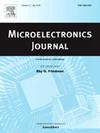A 36× 7 scanning LiDAR sensor with full coincidence detection for background light suppression
IF 1.9
3区 工程技术
Q3 ENGINEERING, ELECTRICAL & ELECTRONIC
引用次数: 0
Abstract
This paper presents a scanning light detection and ranging (LiDAR) with a 36 × 7 array, integrated with coarse and fine quantization time to digital converters (TDCs). A novel coincidence detection circuit is proposed to mitigate the issues of miscounts and missed counts commonly encountered in conventional methods. Furthermore, the system employs a hybrid architecture that combines successive approximation with pipelining, enabling parallel binary quantization of each stage. The chip is designed using a 110 nm CMOS process with a total area of . The coarse quantization TDC adopts an analog counter design, achieving a compact macro-pixel size of . The simulation results demonstrate that the proposed coincidence detection circuit exhibits a higher success rate under varying background light intensities and distances, and the system achieves a depth precision of 0.18% over a measurement range of 48 meters with a frame rate of 50 fps.
一种36x7扫描激光雷达传感器,具有完全符合检测的背景光抑制
本文介绍了一种36 × 7阵列的扫描光探测和测距(LiDAR)系统,该系统集成了粗量化和细量化时间到数字转换器(tdc)。提出了一种新的符合检测电路,以解决传统方法中常见的误计数和漏计数问题。此外,该系统采用混合架构,将逐次逼近与流水线相结合,实现每个阶段的并行二进制量化。该芯片采用110纳米CMOS工艺设计,总面积为1.15mm2。粗量化TDC采用模拟计数器设计,实现了紧凑的宏像素尺寸55×55μm2。仿真结果表明,所提出的符合检测电路在不同背景光强度和距离下具有较高的成功率,在48米的测量范围内,以50 fps的帧率实现了0.18%的深度精度。
本文章由计算机程序翻译,如有差异,请以英文原文为准。
求助全文
约1分钟内获得全文
求助全文
来源期刊

Microelectronics Journal
工程技术-工程:电子与电气
CiteScore
4.00
自引率
27.30%
发文量
222
审稿时长
43 days
期刊介绍:
Published since 1969, the Microelectronics Journal is an international forum for the dissemination of research and applications of microelectronic systems, circuits, and emerging technologies. Papers published in the Microelectronics Journal have undergone peer review to ensure originality, relevance, and timeliness. The journal thus provides a worldwide, regular, and comprehensive update on microelectronic circuits and systems.
The Microelectronics Journal invites papers describing significant research and applications in all of the areas listed below. Comprehensive review/survey papers covering recent developments will also be considered. The Microelectronics Journal covers circuits and systems. This topic includes but is not limited to: Analog, digital, mixed, and RF circuits and related design methodologies; Logic, architectural, and system level synthesis; Testing, design for testability, built-in self-test; Area, power, and thermal analysis and design; Mixed-domain simulation and design; Embedded systems; Non-von Neumann computing and related technologies and circuits; Design and test of high complexity systems integration; SoC, NoC, SIP, and NIP design and test; 3-D integration design and analysis; Emerging device technologies and circuits, such as FinFETs, SETs, spintronics, SFQ, MTJ, etc.
Application aspects such as signal and image processing including circuits for cryptography, sensors, and actuators including sensor networks, reliability and quality issues, and economic models are also welcome.
 求助内容:
求助内容: 应助结果提醒方式:
应助结果提醒方式:


